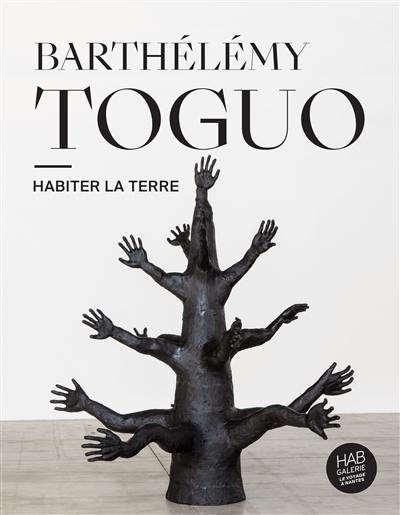
Collection(s) : Les carnets du Voyage à Nantes
Paru le 20/07/2023 | Broché 79 pages
Tout public
Barthélémy Toguo, artiste profondément politique dans sa démarche, est pleinement conscient que nous vivons des temps troubles, de division et de partition. Son œuvre, marquée par l'histoire et la mémoire, est traversée par les questions les plus brûlantes qui hantent le monde contemporain : exil et migration, injustice sociale, racisme et discrimination, crise environnementale... Réunissant des vues d'exposition, des textes sur les œuvres et un entretien avec l'artiste, ce carnet revient sur l'exposition personnelle Habiter la Terre, qui présente la diversité des médiums utilisés par Barthélémy Toguo pour se relier de façon organique et faire rhizome dans le vaste espace de la HAB Galerie.
Situé à la pointe ouest de l'île de Nantes, le Hangar 21 est plus connu sous le nom de Hangar à bananes, un surnom qu'il tient de son histoire. En 2007, propriété du port autonome de Nantes Saint-Nazaire, il est réhabilité à l'occasion de la première édition de l'événement biennal Estuaire Nantes <> Saint-Nazaire. Depuis, cet espace rebaptisé HAB Galerie par Le Voyage à Nantes en 2011 propose tout au long de l'année des expositions d'art contemporain qui sont l'occasion d'une plongée inédite dans l'œuvre d'un artiste, vidéo, sculpture, peinture ou installation, pensée et réalisée in situ.
Barthélémy Toguo's approach as an artist is profoundly political. He is keenly aware that we live in troubled times of division and segregation. His work, marked by history and memory, is permeated with the most burning questions haunting the contemporary world : exile and migration, social injustice, racism and discrimination, and environmental crises... Bringing together images of the exhibition, and texts on the artworks, and an interview with the artist, this booklet reviews the solo exhibition, Habiter la Terre (Living on Earth), which presents the plethora of mediums used by Barthélémy Toguo to make organic connections and create rhizomes in the vast space of the HAB Gallery.
Located at the western tip of the Ile de Nantes, Hangar 21 is best known as the Banana Hangar, a nickname that has to do with its history. Owned by the autonomous port of Nantes Saint-Nazaire, it was rehabilitated in 2007 for the first biennial event called Estuaire Nantes <> Saint-Nazaire. Since then, this space, renamed HAB Galerie by Le Voyage à Nantes in 2011, offers year-round exhibitions of contemporary art, giving visitors a unique opportunity to plunge into the work of an artist, be it in the form of video, sculpture, painting or installation, conceived and produced in situ.
Barthélémy Toguo est né à Mbalmayo, au Cameroun, en 1967. Après des études d'art à Abidjan, à Grenoble et à la Kunstakademie de Düsseldorf, Il s'installe à Paris. Barthélémy Toguo reste enraciné au Cameroun, où II retourne régulièrement et crée Bandjoun Station en 2013. Dès la fin des années 1990, ses œuvres sont remarquées par critiques et conservateurs, qui l'invitent dans de grandes manifestations : Hans Ulrich Obrist pour Migrateurs (1999, ARC, Pafis), Jean-Hubert Martin pour Partage d'exotismes (2000, Biennale de Lyon), Pierre Restany pour Political Ecology (2001, White Box, NY) et Okwui Enwezor pour la Biennale de Venise (2015). En 2016, il est nommé pour le prix Marcel Duchamp et présente Vaincre le virus ! au Centre Pompidou. Ses plus récentes expositions personnelles sont : The Beauty of our Voice (2018, Parrish Art Museum, NY), Désir d'humanité (2021, musée du Quai Branly-Jacques Chirac) et, en 2022, Faith can move Mountains (Villa Merkel, Allemagne), Barthélémy Toguo (musée Picasso, Barcelone), Urban Requiem (SCAD Museum of Art, Savannah, États-Unis). En 2022, il est invité à la Biennale de Sydney et au Louvre où II présente, sous la Pyramide, la monumentale installation Le Pilier des migrants disparus. Ses œuvres sont présentes dans de nombreuses collections françaises et américaines.
Barthélémy Toguo was born in Mbalmayo, Cameroun, in 1967. After doing art studies in Abidjan, Grenoble, and at the Kunstakademie in Dusseldorf, he settled in Paris. Barthélémy Toguo remains rooted in Cameroun, and returns regularly, creating the Bandjoun Station there in 2013. Beginning in the late 1990s, his work is noticed by critics and curators, who invite him to participate in major events : Hans Ulrich Obrist for Migrateurs (1999, ARC, Paris), Jean-Hubert Martin for Partage d'exotismes (2000, Lyons Biennial), Pierre Restany for Political Ecology (2001, White Box, NY) and Okwui Enwezor for the Venice Biennial (2015). In 2016, he is nominated for the prix Marcel Duchamp and presents Vaincre le virus ! at the Centre Pompidou. His most recent solo exhibits are : The Beauty of our Voice (2018, Parrish Art Museum, NY), Désir d'humanité (2021, musée du Quai Branly-Jacques Chirac) and, in 2022, Faith can move Mountains (Villa Merkel, Germany), Barthélémy Toguo (musée Picasso, Barceione), Urban Requiem (SCAD Museum of Art, Savannah, US). In 2022, he is invited to the Sydney Biennial and to the Louvre, where he presents, under the pyramid, a monumental installation of Le Pllier des migrants disparus. His works are present in numerous French and American collections.